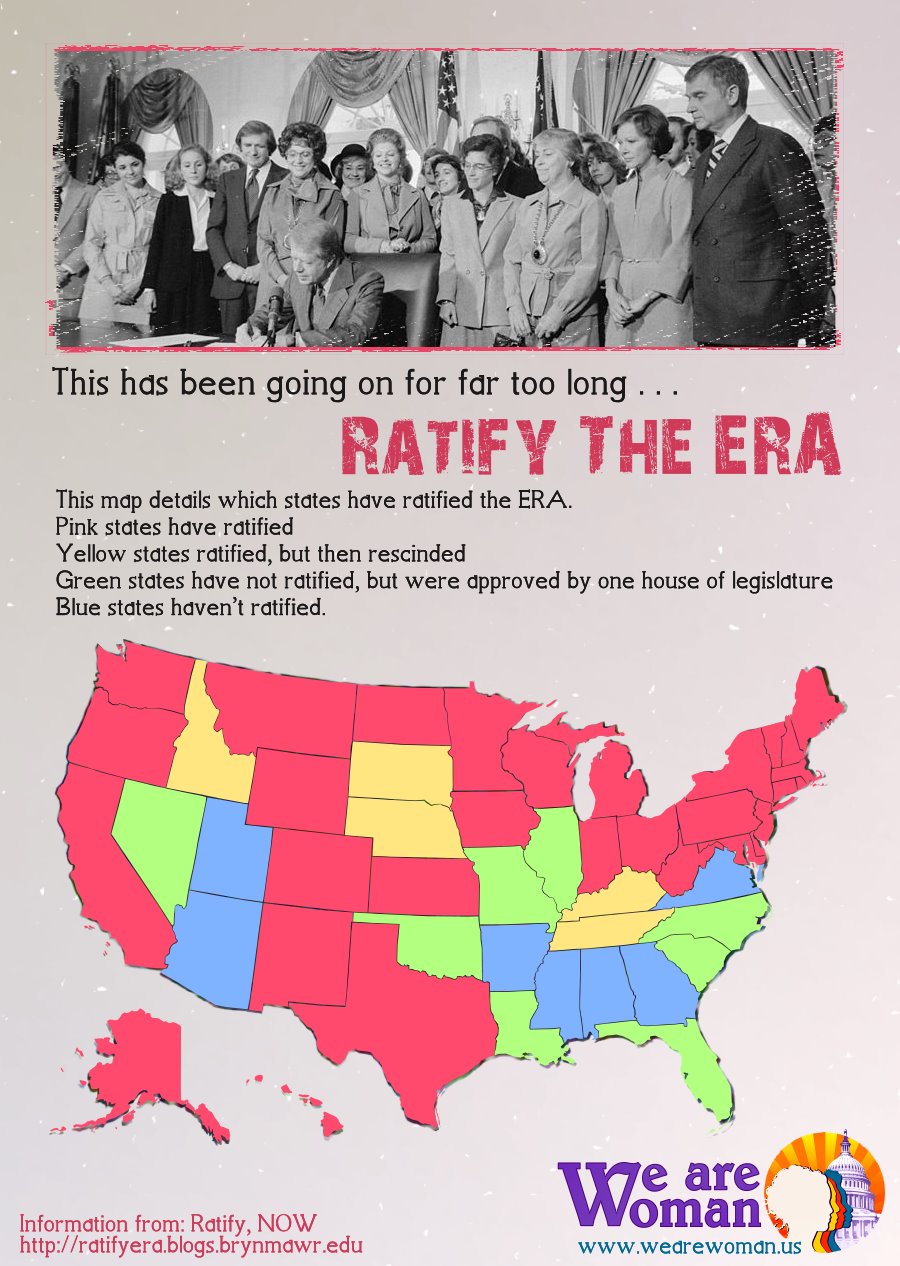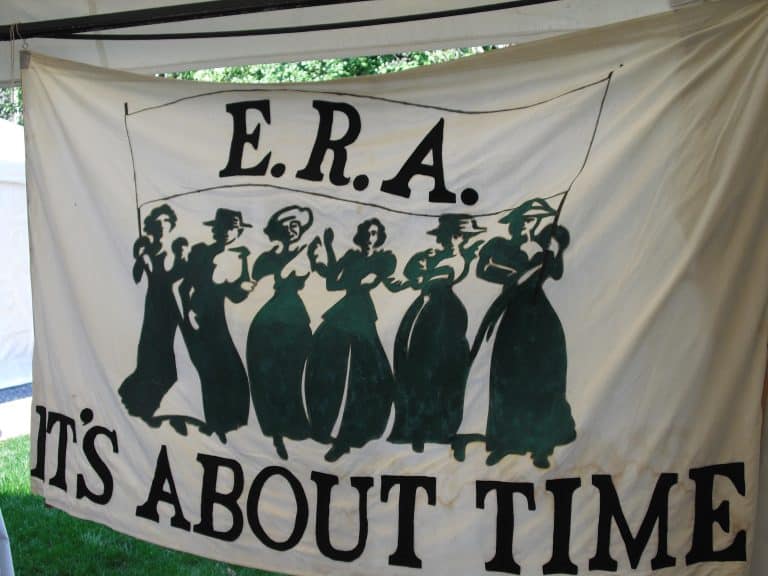 This picture was taken at the Sewall-Belmont House and Museum, home to Alice Paul and the early suffragettes, during the 40th anniversary of the March 22, 1972 passage of the ERA through Congress. I was so inspired by this program that I decided to create a series of posts dedicated to the ERA’s past, present, and future. In this post I give some back ground information on the amendment, in the next post I will outline my personal journey from knowing nothing about the ERA, to reading “Housewife to Heretic,” to becoming a National Council for Women’s Organizations Mormons for ERA Activist! The final post will be dedicated to the future of the ERA and what you can do. Check out the official ERA website for more information: www.equalrightsamendment.org
This picture was taken at the Sewall-Belmont House and Museum, home to Alice Paul and the early suffragettes, during the 40th anniversary of the March 22, 1972 passage of the ERA through Congress. I was so inspired by this program that I decided to create a series of posts dedicated to the ERA’s past, present, and future. In this post I give some back ground information on the amendment, in the next post I will outline my personal journey from knowing nothing about the ERA, to reading “Housewife to Heretic,” to becoming a National Council for Women’s Organizations Mormons for ERA Activist! The final post will be dedicated to the future of the ERA and what you can do. Check out the official ERA website for more information: www.equalrightsamendment.org
I come from a family of strong women. We are opinionated, talented, capable, and hearty. We have faced heartache and trials and through it all we thank the Lord for our blessings. So it was with much surprise when I first learned about the church’s opposition to the ERA or The Equal Rights Amendment. “How can equal rights ever be a bad thing?” I genuinely asked my mother. “I don’t know” she said “the church said it was a moral issue,” she was now racking her brain to remember the reason, “that it would ruin the family if it passed or something like that” she mumbled trailing off, already preoccupied with another task. That was not enough for me. It just did not make any common sense.
The Suffragettes fought and gained the right to vote in 1920 alongside cadres of Mormon women who formed, with official church approval, women’s suffrage associations throughout the West “many, if not all of them, sprang from the women’s auxiliary organizations of the church, most notably the Relief Society. The Woman’s Exponent, an unofficial publication for Mormon women, took up the cause with zeal” (Jean Bickmore White). Championed by Elizabeth Cady Stanton and Susan B. Anthony (albeit with the express purpose that once women had the right to vote they would inevitably reject polygamy), Utah became only the second territory to grant women the right to vote! Three years later in 1923, Alice Paul an indefatigable women’s rights activist realized that the right to vote alone would not end the withstanding discrimination against women under the law and drafted the first Equal Rights Amendment which stated: “Men and women shall have equal rights throughout the United States and every place subject to its jurisdiction. Congress shall have power to enforce this article by appropriate legislation.”
It seems simple enough, banal even. “Men and women shall have equal rights.” Yet, how did the amendment constructed to enforce this law only three years after the LDS church officially approved the use of auxiliary services to fight for the cause of women’s rights become something “immoral?” How could something so seemingly obvious incite such vehement opposition from the very same religion and daughters of the women that brought about women’s suffrage?The answer is a complicated entanglement of time, politics, and fear. From 1923-1970 the ERA was introduced in every session of Congress but only rarely made its way out of committee and when it did it was mired in politics. During this time and without any constitutional protection for women against discrimination under the law (as Justice Scalia argues is still the case), many small battles were fought and won, such as, Equal Pay Acts, protective labor legislation, and equal employment opportunities for women. These small victories presented a problem; they created seemingly unnatural battle lines in these issues with Republicans fully supporting the ERA from 1940-1980 and many Democrats, feminists, and labor groups fearing that they would lose their protective labor rights with the passage of the ERA. This battle waged on until the women’s rights movement of the late 1960’s-1970’s when the creation of the National Organization for Women (NOW) and the Women’s Strike for Equality dredged up the flailing ERA rewritten by Paul in 1943 to state: “Equality of rights under the law shall not be denied or abridged by the United States or by any state on account of sex.” On March 22, 1972 the ERA was approved by Congress in a rushed bid that actually made Alice Paul cry, but not out of joy. She feared that the bargain made to get the ERA through Congress, accepting a seven year deadline for the ratification of 38 states, would be its biggest downfall. She was right.
While the ERA was ratified rapidly at first, thirty ratifications by 1973, its numbers slowed drastically throughout the next decade with many rescinding their ratifications and tragically dishonest and amoral politicking along the way. Eleanor Smeal still has pain in her voice as she talks about the long fought ratification that was “lost” on its way to the archives or the one that was valiantly celebrated on Nevada’s congress floor with a brilliant last minute maneuver to outwit the filibustering opposition only to be overturned that very night in a private meeting of male-only congressmen, some imprisoned for taking bribes later on, but the state remaining unratified by the deadline regardless. There was incredible pressure and lobbying from health insurance companies spending enormous amounts of money to reject or rescind the ratification of the ERA because they would be greatly impacted by laws prohibiting sex discrimination because they charged (and still do) women significantly more than men for health insurance. There was also a heavy backlash of social conservatives against the ERA, who feared women’s rights and the women’s movement as a threat to traditional power structures. The church was a notable opponent to the ERA (a position that will be further explained in the next post on this series) and promulgated literature, read messages from the pulpit, and called and set apart sisters to vote against the ERA in unratified states because it was a serious moral issue which could potentially: force women into the draft, mandate unisex bathrooms, extend legal protection to same-sex couples, blur eternal gender roles, and harm the traditional family (The Church’s Official ERA Stance). Despite fighting for and gaining a three-year extension, the ERA remained three states short of being ratified.
 With all of the current debates about gender discrimination and the affordable health care act I cannot help but wonder where we would be had the ERA been ratified 40 years ago. Instead of spending all our time and money fighting each of these little battles, we could have had freedom from discrimination in the constitution. Women and men would have equal rights under the law. That is something our fore-mother’s fought for, something that we MUST make happen, and something our granddaughters will be surprised was not always an inalienable right. “Why would equal rights ever be a bad thing?” I want my future progeny to ask me. “I don’t know,” I will say, “I just don’t know, but I never stopped fighting.”
With all of the current debates about gender discrimination and the affordable health care act I cannot help but wonder where we would be had the ERA been ratified 40 years ago. Instead of spending all our time and money fighting each of these little battles, we could have had freedom from discrimination in the constitution. Women and men would have equal rights under the law. That is something our fore-mother’s fought for, something that we MUST make happen, and something our granddaughters will be surprised was not always an inalienable right. “Why would equal rights ever be a bad thing?” I want my future progeny to ask me. “I don’t know,” I will say, “I just don’t know, but I never stopped fighting.”
At the bottom of the 40th anniversary program there was this beautiful quote:
“Courage doesn’t always roar. Sometimes courage is the quiet voice at the end of the day saying, ‘I will try again tomorrow’” –Mary Anne Radmacher.
Do you agree with this quote? How can we be courageous in the face of national and religious opposition? Why has it almost been 100 years since the original ERA was drafted and it is still not law? Are women’s rights different than any other human rights? What is different about the right to vote and the right to be protected against discrimination under the law? What do you remember about the ERA past? What would you like to know about the ERA present? Or the ERA Future?


